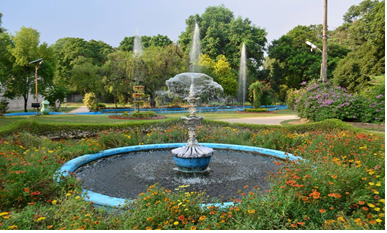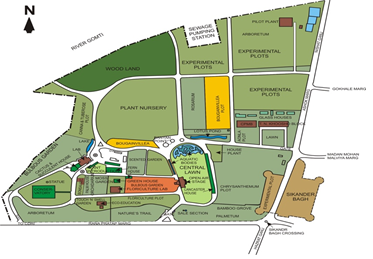CSIR-NBRI Botanic Garden, Lucknow: A National Facility
CSIR-NBRI Botanic Garden, Lucknow: A National Facility
 The Botanic Garden of CSIR-National Botanical Research Institute, Lucknow (popularly known as NBRI Botanic Garden) is a historical garden established in 1789 AD. It was a royal garden gifted by Saadat Ali Khan, the then Nawab of Oudh, to his queen, and named it as Sikandar Bagh after her name. In subsequent years, the garden was renamed "Government Horticultural Garden" and "National Botanic Garden". It is in the heart of Lucknow city, the capital of Uttar Pradesh. Spread over an area of 65 acres, the garden houses more than 6000 important plant species/varieties collected from different parts of India and abroad.
The Botanic Garden of CSIR-National Botanical Research Institute, Lucknow (popularly known as NBRI Botanic Garden) is a historical garden established in 1789 AD. It was a royal garden gifted by Saadat Ali Khan, the then Nawab of Oudh, to his queen, and named it as Sikandar Bagh after her name. In subsequent years, the garden was renamed "Government Horticultural Garden" and "National Botanic Garden". It is in the heart of Lucknow city, the capital of Uttar Pradesh. Spread over an area of 65 acres, the garden houses more than 6000 important plant species/varieties collected from different parts of India and abroad.
Fulfilling all the functions of a botanic garden, the NBRI Botanic Garden is well-known for its immense contributions towards research, education, recreation, and conservation of important plant resources. The plants with economic, taxonomic, ornamental, horticultural, biological, ecological, educational or recreational values have been conserved in the garden for their sustainable utilization. More than one thousand morning walkers visit the garden every day. The serene ambience under the large Banyan tree is ideal for meditation and relaxation.
The NBRI Botanic Garden is a part of the Botanic Gardens Conservation International (BGCI) network and shares/exchanges plant resources worldwide. It is a living repository of various native and exotic plants displayed in its plant houses and arboreta. The garden has an excellent collection of ornamental crops, trees, houseplants, medicinal plants, cycads, palms, ferns, bryophytes, bonsai, water lilies, cacti and succulents. There are several thematic gardens and plant houses where plants are displayed for educational and aesthetic purposes. The 'Touch and Smell Garden' is a unique place for visually challenged visitors, where audio and Braille system support have been provided. The "Know Your Plants" section displays plants of daily use to raise children's awareness of the plants. The NBRI Botanic Garden has excellent infrastructural facilities for propagation, including modern nurseries, experimental plots, propagation units, mist chambers, and drip irrigation facilities.
Considering the rich plant diversity of the NBRI Botanic Garden, the Institute has been designated as a Living National Repository by the National Biodiversity Authority, Chennai. Besides, this Botanic Garden is one of the Lead Botanic Gardens under ABG Scheme of Ministry of Environment, Forests and Climate Change, Government of India. The institute has been designated as DUS Centre for Bougainvillea, Gladiolus, and Canna by the Protection of Plant Varieties and Farmers' Rights Authority (PPV&FRA), Ministry of Agriculture & Farmers Welfare, Government of India.
 The Botanic Garden has an excellent germplasm collection of ornamental crops with 202 cultivars of Bougainvilleas, 115 cultivars of Gladiolus, 200 cultivars of Chrysanthemums, 45 cultivars of Canna, and 125 cultivars of Roses. Fifteen species/cvs./races of Nelumbo nucifera (Lotus) and Nymphaea spp. (water lilies) are conserved in the garden. Besides the ornamental crops, the garden also has germplasm collections in different plant houses: an arch-shaped Conservatory for Tropical and Subtropical Plants (300 species/cultivars); a Cactus and Succulent House (350 species/varieties); a Palm House with 52 species; a Cycad House (70 species), an Orchidarium (120 species), a Gerbera House, a Fern House (100 species of ferns and fern allies) and a Moss House (20 species). The Botanic Garden also has an arboretum which has around 400 species of trees and shrubs.
The Botanic Garden has an excellent germplasm collection of ornamental crops with 202 cultivars of Bougainvilleas, 115 cultivars of Gladiolus, 200 cultivars of Chrysanthemums, 45 cultivars of Canna, and 125 cultivars of Roses. Fifteen species/cvs./races of Nelumbo nucifera (Lotus) and Nymphaea spp. (water lilies) are conserved in the garden. Besides the ornamental crops, the garden also has germplasm collections in different plant houses: an arch-shaped Conservatory for Tropical and Subtropical Plants (300 species/cultivars); a Cactus and Succulent House (350 species/varieties); a Palm House with 52 species; a Cycad House (70 species), an Orchidarium (120 species), a Gerbera House, a Fern House (100 species of ferns and fern allies) and a Moss House (20 species). The Botanic Garden also has an arboretum which has around 400 species of trees and shrubs.
The R&D activities of the NBRI Botanic Garden focuses mainly on germplasm collection, conservation of threatened species, development of new floricultural varieties and cultivars of ornamental crops, and mutation breeding through chemical and gamma-irradiation. The Botanic Garden organizes two annual flower shows for creating awareness of floriculture among the masses.
The Botanic Gardens organizes a regular training programme in ornamental horticulture for students, gardeners and the public. Saplings and seedlings of various ornamental and medicinal plants can be purchased from the Sales Section in the garden.
JS Khuraijam, SK Tewari and SK Barik
CSIR-National Botanical Research Institute

 Pensioners Corner
Pensioners Corner Screen Reader Access
Screen Reader Access Skip to main content
Skip to main content

























